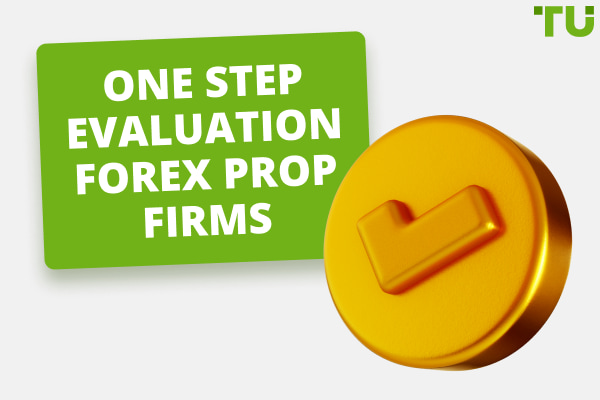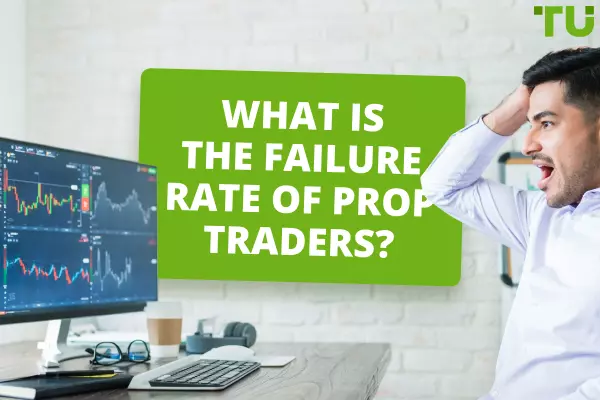How to Turn $100 Into $1000 in Prop Trading
How to turn $100 into $1000 in prop trading
-
Choose the right pro-payment company
-
Get vetted and get funding
-
Develop a trading strategy for different cases
-
Develop a risk management plan
-
Start trading, analyze results, improve strategy
In the field of finance and investment, there are many ways to increase capital. Prop trading occupies a special place among them. This trading method offers an opportunity with a small starting capital to multiply your funds in the shortest possible time. Every person at least once in his life has thought about how to increase 100 dollars. Taking even such an amount as a basis, a prop trader can make it a starting point for achieving financial goals - from $1000 and higher. In this article, the experts at Traders Union will focus on the specific steps needed to turn $100 into $1,000 in prop trading.
-
How to invest $100 in $1,000?
There are several ways to multiply $100, such as investing in stocks in the market, trading forex or copy trading on your own, buying cryptocurrency on exchanges, creating an online business, and participating in referral programs. However, prop trading, which involves using leverage to trade the financial markets, is one of the most likely ways to achieve this goal.
-
How to make $1000 quickly in prop trading?
To earn 1000 dollars on prop trading, you can use different strategies such as day trading stocks, trading the foreign exchange market, trading cryptocurrency or options. The effectiveness of each strategy depends on the market situation, level of experience and risk tolerance. The main thing is to choose the right prop company for cooperation.
-
How much do prop traders earn on average?
The average income of prop traders can vary greatly depending on their experience, the success of their strategies, and market conditions. Some may earn a few thousand dollars a month, while others earn significantly more and make tens or hundreds of thousands. In any case, it is important to keep in mind that trading on the financial markets is always risky and earnings are not guaranteed.
-
What are the benefits of a career in prop trading?
A career in prop trading offers significant financial opportunities, as traders can receive a portion of the profits from their trades. In addition, prop traders have flexible working hours and can trade from anywhere in the world using the internet. Also, by working in proprietary trading, traders have access to modern financial tools and analytical resources.
10 steps to turn $100 into $1000 in prop trading
How to turn 100 dollars into 1000 dollars in prop trading? Traders Union specialists know the answer to this question and have prepared a step-by-step algorithm for everyone.
Step 1: Assessment of skills and knowledge
The first step of a trader to successful prop trading with small initial capital is an objective assessment of his own financial knowledge and trading skills. Basic market concepts, market types, technical and fundamental analysis, as well as risk management and market psychology should be studied.
Step 2: Selecting the right proprietary firm
After a trader has assessed his skills, the next step is to find a prop firm that offers savings accounts with a minimum deposit. When choosing one, one should pay attention to its reputation, commissions, trading conditions, customer support and the quality of services provided.
Step 3: Submitting an application and passing the verification process
Next, you can apply to open a savings account with the selected proprietary firm. Usually, the trader will be required not only to provide the firm with personal data for verification, but also to undergo an additional check on the knowledge of the basics of trading and financial markets.
Step 4: Study the trading platform
Once the trader's application has been approved, it makes sense to study in detail the trading platform provided by the prop firm, familiarizing yourself with its functionality, nuances of operation, available analysis tools and ways of executing trades. This knowledge is important for a prop trader.
Step 5: Develop a trading strategy
A trader determines his/her approach to trading and develops an appropriate trading strategy based on knowledge, experience, goals and attitude to risk. At the same time, market analysis methods are chosen, entry and exit conditions and other technical aspects are established.
Step 6: Develop a risk management plan
It is worth thinking about the risk management plan as much as possible, defining the size of positions, stop-losses and the percentage of investment capital that the trader is willing to risk in one transaction, per day, per week, per month, etc. Adjustments to take-profit levels are also encouraged.
Step 7: Start trading
It is always advisable to start trading with minimum volume. This is done to evaluate the effectiveness of a particular trader's strategy and risk management plan. If anything, this approach will minimize losses from unsuccessful contracts.
Step 8: Analyze the results and improve the strategy
To grasp the process of transforming $100 into $1,000 through prop trading, traders need to consistently assess trade outcomes, recognize strategy strengths and weaknesses, and adapt as necessary for better performance.
Step 9: Increase the volume of trades
As a trader becomes more confident and successful in trading, he gradually increases the volume of his trades. This is a natural process that leads to an increase in potential profits. However, it's advisable to proceed with caution in this matter.
Step 10: Portfolio diversification
Once a trader has achieved the desired results and increased his capital, he can consider diversifying his portfolio by adding new financial instruments or trading strategies. This tends to increase income and minimize risk.
Best prop firms
Is prop trading with $100 possible?
Prop trading, in which a trader trades the firm's funds using leverage, is usually associated with large initial capital. However, there are companies that offer the opportunity to start trading with minimal capital, including as little as $100. These companies usually offer prop trading savings accounts where the trader is given access to the firm's capital to trade in the financial markets.
The basic principle of such firms is to provide the trader with leverage of several times the amount of his own deposit. This allows the trader to increase potential profits from his trades using the firm's capital. In addition to being able to trade with minimal capital, a $100 prop trading account can be useful for those who want to learn about the financial markets and develop their trading skills without taking big risks.
Companies that provide prop trading savings accounts usually charge the trader a monthly subscription amount to use their services and platform. This is generally the only cost. When choosing a company for a $100 prop trading account, it is also important to look at the quality of customer service, training resources, and availability of support. Good support and training can be crucial factors in successfully starting to trade the markets.
How does prop trading work?
Prop trading (from "proprietary trading" - "private trading") is a form of trading in financial assets, in which traders use the firm's capital, rather than their personal funds, to make transactions in the market. Unlike individual trading, where traders work with their own funds, in proprietary trading the capital is provided by a specialized firm interested in their success. Thus, proprietary trading is a partnership between a trader and a company that acts as an investor or sponsor.
Prop trading allows traders to leverage a large amount of leverage and hence increase their income opportunities. Additionally, proprietary trading offers access to capital and technology resources provided by the sponsoring firm. Clients can utilize advanced trading platforms, analytical tools and receive support from experienced professionals.
Prop trading utilizes any known strategy to generate profits, including day trading, trading based on technical or fundamental analysis, arbitrage, and others. Traders in prop trading earn a portion of the profits from their trades. This usually comes in the form of commissions or percentages of profits that are paid to the proprietary firm. Commissions can vary depending on the terms of the agreement and the size of the trade.
Risk management tips for prop traders
Prop trading from $100 to $1,000 dollars may seem like a simple matter for some. This can be true if you learn to treat the risk factor correctly. For both beginners and experienced prop traders, TU experts give 8 practical tips on how to manage risk:
-
Always set stop-losses and take-profits. It is worth thinking in advance about stop-loss levels to exit losing trades and take-profit levels to close profitable positions. It is important to use stop-limit orders to protect yourself from unexpected market movements
-
Allocate traders’ capital between different financial instruments and markets to reduce the risk of loss due to price fluctuations in one asset. Avoid staking an amount exceeding what you can comfortably afford to lose
-
Study and analyze the market to keep abreast of current trends and possible risks. Apply technical and fundamental analysis to make informed decisions
-
Clearly define the size of each position depending on the capital and the level of risk that can be accepted. As a rule of thumb, it is recommended not to risk more than 1-2% of total capital in a single trade
-
Adhere to a proprietary trading plan. You need to stick to your trading plan and strategy, even if the market starts behaving unexpectedly. Discipline and consistency will help you avoid emotional decisions that usually lead to big losses
-
Keep a trading journal. It is important to have a trade diary where the trader records all trades including entries, exits, reasons for opening the trade and results. This helps in analyzing the trade, identifying mistakes and improving the strategy
-
Be prepared for failure. Loss is an inherent risk in trading. Even the most experienced traders sometimes suffer losses. It is necessary to treat them adequately and not to allow one unsuccessful trade to undermine the trader's confidence
-
Use market cycle analysis. It is advisable to study and understand market cycles in order to adapt a strategy depending on the current market phase. The trader should consider possible changes in market sentiment and react accordingly
According to Rinat Gismatullin it's crucial to keep in mind that succeeding in $100 prop trading, although affordable, still demands time, effort, and training. Don't buy into the illusion that small amounts are small risks. It doesn't matter if the prop funds are $100 or $10,000 if they are mismanaged, the risk of losing them is the same.
Other ways to turn $100 into $1000
In answering the question of how to turn $100 into $1,000 in prop trading, we should not forget about other financial areas that also present this opportunity. TU experts review the most common of such ways: referral programs, trading cryptocurrency and other assets, copy trading, investments, participation in ICO.
Referral programs
Referral programs offer rewards for bringing new customers to a platform or service. There is usually a commission or bonuses for each new user who performs certain actions (say, simply registering) through a unique invitation link. For example, an investor may receive a bonus in the form of free shares or an additional deposit to their account for each friend or acquaintance who opens an account on the platform and invests a certain amount.
Trading cryptocurrency and other assets
Classic independent trading will always remain the most popular method of "scrolling" small and large amounts of money. A starting capital of $100 is enough to start individual trading on many platforms, especially if leverage is used. In addition to crypto coins, the objects of trading can be stocks on margin exchanges, currencies on Forex, futures, index options or CFD contracts.
Copy trading
Copy trading is an investment strategy in which an investor copies the trading operations of experienced traders. There are several platforms where you can find successful traders and copy their strategies automatically or manually. When the selected trader opens or closes a contract, the investment account automatically repeats the same actions in proportion to the investor's portfolio. If the trader makes profitable trades, the investor's account will also increase.
Investments
Investing in ETFs - exchange traded funds that track the performance of a particular index, sector or industry - has been gaining momentum recently. Investing in ETFs is available for capital of any size. Investing in crowdfunding programs is also interesting. Crowdlending allows companies to raise funding from the general public through online platforms. Investors invest in a variety of projects, starting with very small amounts, and receive a share of profits or other rewards in return.
Participation in ICO (Initial Coin Offering)
An ICO is a form of raising investment in new cryptocurrency projects. Investors can purchase tokens of a new cryptocurrency in hopes of future growth. Some ICOs can start with very low values, allowing for an investment of $100 and sometimes smaller amounts. Profits in the case of a sharp rise in the project can be multiplied dozens and sometimes even hundreds of times.
Conclusion
Prop trading is a productive approach to trading in financial markets that allows traders to utilize a firm's capital to generate profits, often using high-frequency algorithms. The benefits of prop trading include access to significant capital, technical resources and analytics, as well as potentially high returns when traded correctly.
Experienced market participants know how to turn $100 into $1,000 in prop trading. With good planning and the use of advanced trading tools, this is entirely possible. To do so, it is important to have a thorough understanding of market conditions, effective strategies and risk management, as well as technical and fundamental analysis skills.
Glossary for novice traders
-
1
Broker
A broker is a legal entity or individual that performs as an intermediary when making trades in the financial markets. Private investors cannot trade without a broker, since only brokers can execute trades on the exchanges.
-
2
Trading
Trading involves the act of buying and selling financial assets like stocks, currencies, or commodities with the intention of profiting from market price fluctuations. Traders employ various strategies, analysis techniques, and risk management practices to make informed decisions and optimize their chances of success in the financial markets.
-
3
Prop trading
Proprietary trading (prop trading) is a financial trading strategy where a financial firm or institution uses its own capital to trade in various financial markets, such as stocks, bonds, commodities, or derivatives, with the aim of generating profits for the company itself. Prop traders typically do not trade on behalf of clients but instead trade with the firm's money, taking on the associated risks and rewards.
-
4
Leverage
Forex leverage is a tool enabling traders to control larger positions with a relatively small amount of capital, amplifying potential profits and losses based on the chosen leverage ratio.
-
5
Cryptocurrency
Cryptocurrency is a type of digital or virtual currency that relies on cryptography for security. Unlike traditional currencies issued by governments (fiat currencies), cryptocurrencies operate on decentralized networks, typically based on blockchain technology.
Team that worked on the article
Winnifred Emmanuel is a freelance financial analyst and writer with years of experience in working with financial websites and businesses. Her expertise spans various areas, including commodities, Forex, stocks, and cryptocurrency. Winnifred tailors her writing to various audiences, including beginners, while also providing useful insights for those who are already familiar with financial markets.
Dr. BJ Johnson is a PhD in English Language and an editor with over 15 years of experience. He earned his degree in English Language in the U.S and the UK. In 2020, Dr. Johnson joined the Traders Union team. Since then, he has created over 100 exclusive articles and edited over 300 articles of other authors.
Mirjan Hipolito is a journalist and news editor at Traders Union. She is an expert crypto writer with five years of experience in the financial markets. Her specialties are daily market news, price predictions, and Initial Coin Offerings (ICO).















